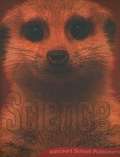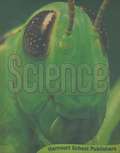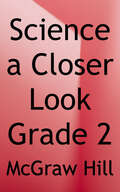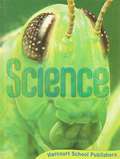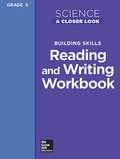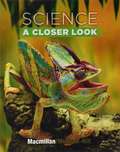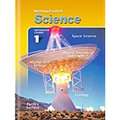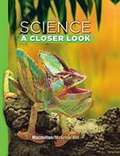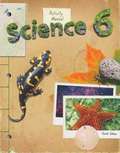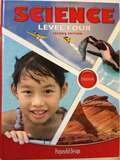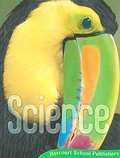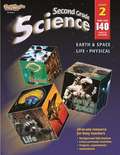- Table View
- List View
Science (Grade #2)
by HarcourtHarcourt science covers science broadly in 3 topics namely life, earth and physical.
Science (Grade #5)
by Harcourt School PublishersThis book is comprised of lessons of Life Science, Earth Science and Physical Science in an easy-to-learn format.
Science (Grade #6)
by Harcourt School PublishersThis text book contains unit lessons on Understanding Living Things, Interactions in Ecosystems, Exploring Earth, Cycles on Earth and in Space, Matter and Energy and Forces and Machines.
Science: An Issues-based Program (Grade #7)
by Manisha Hariani Sara Dombkowski Din SeaverScience textbook for 7th graders.
Science: A Closer Look (Elementary Science Closer Look Series)
by McGraw HillThe Grade 2 Student Edition covers units such as Plants and Animals, Habitats, and Our Earth.
Science: Technology and Society Sourcebook
by Holt Rinehart Winston StaffScienceplus Sourcebook for High School
Science: Teaching School Subjects 11-19 (Teaching School Subjects 11-19)
by Vanessa Kind Keith S. TaberIn recognizing that new teachers often feel disempowered by the subject expertise they bring into teaching, this book not only covers the training standards for NQTs and the Induction Standards, but takes the reader beyond this by fully exploring issues relating to subject knowledge in learning to teach.Divided into three sections the book covers: framing the subject - defining subject knowledge and focusing on questions about science as a school subject teaching the subject - looking at pedagogical, curricular and pupil knowledge science within the professional community - focusing on the place of science within the wider curriculum and the teaching community. This refreshing new book provides stimulating assistance to subject specialists, from new teachers of science in the early years of professional development to those on a PGCE course or in their induction year. It is also suitable for subject leaders with mentor responsibilities and Advanced Skills Teachers undertaking specialist inset and teaching support.
Science: A Closer Look [Grade 5], Building Skills, Reading and Writing Workbook
by MacmillanA 5th grade science workbook that accompanies the textbook "Science a closer look" grade 5
Science: Earth and Space
by Erica Martin Jeremy Foster Christine Hotke Dawn Mckenzie Greg Parker Delores Shimmin Dewitt SteeleScience textbook with a Christian perspective.
Science: Integrated Course 1
by Mcdougal-Littell Publishing StaffIntegrated Science pulls together units from the different categories of science to give you a broad picture of how scientists study nature.
Science
by McGraw-HillScience textbook. As you read, you'll learn about the Methods of Science, the steps scientists follow to solve problems.
Science: A Closer Look
by Macmillan McGraw-HillThe Grade 4 Student Edition covers units such as Living Things, Ecosystems, Matter, and Forces of Energy.
SCIENCE: Order & Design
by Dawn McKenzieExplore the many wonderful levels of creation with this colorful and beautifully designed book! From taking a look at the things you might find in your backyard to the species that occupy the rainforest, your child will receive a greater understanding of the beautiful world that God has created. Other topics included are healthy living, the miraculous stages of a baby’s development, exploring the animals of the sea, the intricate designs of the plant life, and more! Section reviews are included to support the information that your child has learned in each lesson.
Science: Order & Design
by Dawn Mckenzie Jeremy Foster Erica Martin Laurel Hicks Delores Shimmin Gregory RickardStudents are introduced to the scientific method and encouraged to apply it throughout this Christian life science text. They investigate fields such as botany, anatomy, zoology, microbiology, and ecology with the goal of discovering the thoughts of the Creator through the ingenious structure and orderly function of His creation.
Science: Student Activity Manual, Grade 6
by Bju PressThe Science 6 Activity Manual provides pages to record results and conclusions for Activities as well as reinforcement pages, study guides, and enrichment pages.
Science: Level Four
by Purposeful Design Publications Various RolesScience level four by Purposeful Design... The world you live in is amazing in it's beauty, complexity, and order! Science lets you explore and learn about how things are made and how they work. God designed you to be inquisitive. God wants you to see Kim! Jeremiah 29:13 "You will seek me and find me when you seek me with all your heart"
Science: Life, Physical, Earth And Space (Science Series)
by Steck-Vaughn StaffSteck-Vaughn Second Grade Science features over 140 activities across earth & space science, life science, and physical science. Background information, cross-curricular activities, projects, experiments, and assessments are provided, along with a line-listed answer key in the back. 176 pages, reproducible for home/classroom use. 2nd Grade.
Science: Teaching School Subjects 11-19 (Teaching School Subjects 11-19)
by Keith Taber Vanessa KindIn recognizing that new teachers often feel disempowered by the subject expertise they bring into teaching, this book not only covers the training standards for NQTs and the Induction Standards, but takes the reader beyond this by fully exploring issues relating to subject knowledge in learning to teach. Divided into three sections the book covers: framing the subject - defining subject knowledge and focusing on questions about science as a school subject teaching the subject - looking at pedagogical, curricular and pupil knowledge science within the professional community - focusing on the place of science within the wider curriculum and the teaching community. This refreshing new book provides stimulating assistance to subject specialists, from new teachers of science in the early years of professional development to those on a PGCE course or in their induction year. It is also suitable for subject leaders with mentor responsibilities and Advanced Skills Teachers undertaking specialist inset and teaching support.
Science: An Issues-Based Program (Grade 6 )
by University of California at Berkeley Lawrence Hall of ScienceIssues and Earth Science uses several kinds of activities to teach science. For example, you will observe and test the properties of soil, rocks, and minerals. You will examine a model of the way water moves earth materials to change the surface of the land. You will conduct a computer simulation to investigate the causes of earthquakes and volcanoes. A combination of experiments, readings, models, debates, role plays, and projects will help you uncover the nature of science and the relevance of science to your interests.
Science: A Closer Look (New York Edition)
by Joanne Vasquez Richard H. Moyer Jay K. HackettScience textbook for New York students.
Science 1: Student Guide, Part 1
by K12Hands-on exercises and reflections on topics such as: Acting Like a Scientist Matterland Everyday Weather Animal Classification Adaptations
